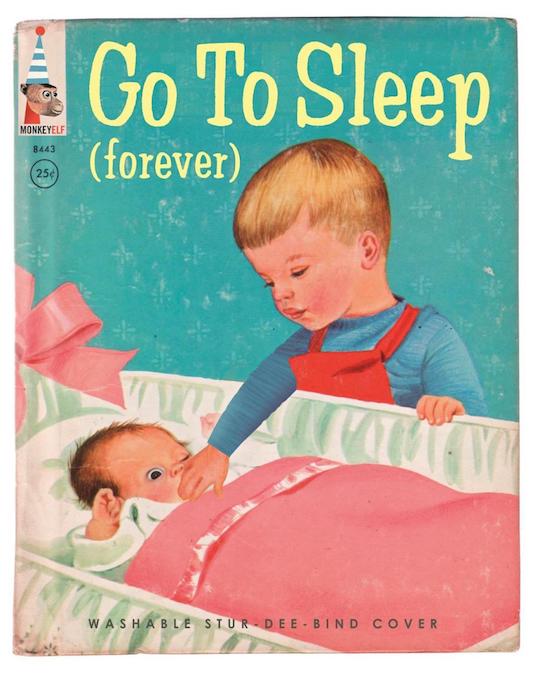Following accusations of racism, Abrams has taken the collection of satirical illustrations Bad Little Children’s Books off the market at the author’s request. The pseudonymous Arthur Gackley maintains that neither he nor his book is prejudiced, but that public outcry has made it impossible to have “the kind of dialogue I hoped to promote.” If that sounds suspiciously high-minded to you, you’ll love his quote in The Guardian:
This act of censorship is dangerous on so many levels, as free speech, satire and parody are tools to help make us a stronger society, not a more divided one.
Totally true re: speech and satire, but I question his use of the phrase “act of censorship.” When you pull your own book because people said you were a jerk for writing it, that’s not censorship. That’s free speech convincing you. I’m kind of surprised it did, though, because the speech used to condemn Bad Little Children’s Books seems like the wrong way to convince anybody. Example after the jump.
Here’s Kelly Jensen at Bookriot, who argues that Bad Little Children’s Books is not funny but racist, Islamophobic and, in a low moment, disrespectful to people who choose to have plastic surgery. She starts by assuring us that she enjoys dark humor, which seems questionable. Her assessment of the “Mommy Needs to Go to Detox” cover, for example, is “Parental alcohol abuse is, indeed, a barrel of laughs. Especially for children impacted by it.”
By definition, dark humor is about subjects that aren’t funny to the people involved, q.v. The House of Yes. But Jensen allows that covers like “The Botched Facelift” are not offensive, just tepidly unfunny. I agree with her. I also agree that the cover below is offensive, but the conclusions she draws from that are so overblown as to force me back into disagreement again. Behold:
That’s not funny. “Burkaday” is a pretty superficial pun on “birthday,” and the notion that people who wear burkas distribute bombs is hackneyed. It’s also racist. Jensen and I agree on this point, but what she goes on to say makes it impossible for me to stay with her. Quote:
This is the sort of harmful imagery and stereotyping that literally kills lives—and it’s not the lives of little white boys who are dying. It’s the lives of those, like the girl in the burka, who are impacted by disgusting “humor” like this.
I’m not sure this imagery “literally kills lives.” There’s a connection through Islamophobia, but to put a racist parody illustration on the same level as invading Iraq or attacking Sikhs on the subway is to urge sensible readers to disagree. Here lies the problem. I agree with Jensen’s assessment that this image is racist. But I have to buy it in the same package as stuff like this:
This “humor” adds to the misinformation, adds to the hatred, and ultimately, makes living in this society more frustrating, difficult, and dangerous for so many. And this “humor” is the kind of garbage that needs to be eliminated at all levels, particularly in publishing.
See, that’s that shit I don’t like. Racial prejudice is the kind of garbage that needs to be eliminated at all levels, but humor—even crappy, racist humor—is not. It is an epiphenomenon of the real problem. The difference here is precisely one of kind, and to ignore that difference—say, by equating joke illustrations to literally killing people1—is to introduce an off-putting flaw to an argument reasonable people would otherwise accept.
This is a consistent problem in progressive discourse: the tendency to argue that any expression of prejudice is violence. It’s a great way to start from a premise we all agree on and lose everyone but your most committed supporters. We draw a distinction between speech and violence because unintended problems emerge from restricting speech, whereas almost nothing bad comes from restricting violence. To ask those who agree with you to elide the difference between racist speech and racist violence is to make their acceptance of one popular premise contingent on their rejection of another.
You don’t convince people by speaking to the purest expression of your opinion. You convince them by speaking to the overlaps between your opinion and theirs. In a project as important as fighting prejudice, we can’t demand total agreement. Not everyone is going to eat the whole meal. We have to feed them a little bit at a time, and get them to swallow “this illustration is racist” instead of trying to shove “we must stamp out racist humor in publishing” down their throats. Doing otherwise encourages them to spit out the whole thing.






“We draw a distinction between speech and violence because unintended problems emerge from restricting speech, whereas almost nothing bad comes from restricting violence.”
I like that line. I wish you could have come to it through something other than a (sharp) critique of an idiotic critique of an idiotic piece of work. If this blog isn’t exactly using straw men, they’re still pretty flimsy adversaries.
Whether or not I m too sensitive and whether or not I m too PC doesn t matter. This book is the problem we re having in America, and because it s the kind of book that will be gifted and shared, particularly this holiday season, it s a fucking travesty of humor that only serves to further disenfranchise and kill our fellow human kind.